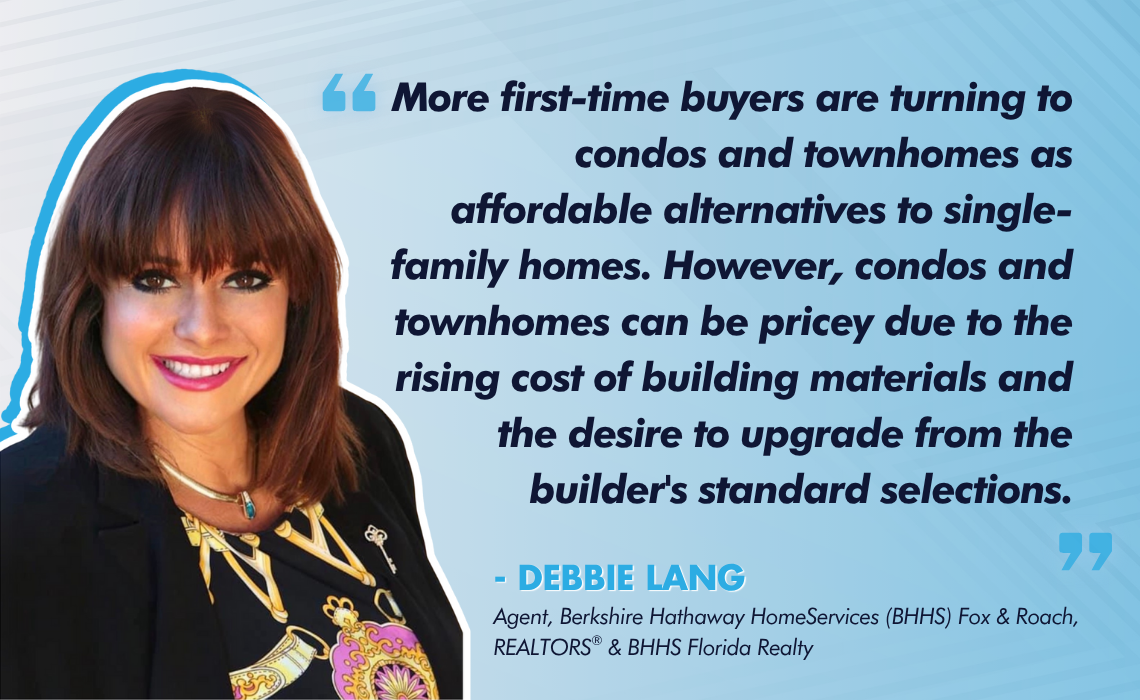While mortgage rates have stabilized somewhat and inventory issues have abated in some parts of the country, the fact is that home prices, especially for first-time buyers, are still an issue. Thus, condos and co-ops, often less pricey than single-family homes, have become more logical options.
“It depends on the building, but condos can be a perfect starter purchase, especially in boutique condos, which may be self-managed, where the monthly fee is almost always lower than in a high-rise building with amenities,” says Rosser Thistle. “A buyer will also need to budget for the capital contribution, which is two to three months of condo fees. This goes into the reserves at closing and will not be returned.
“There are more condos for sale than houses. They generally sell slower than homes. Getting into a condo can be more of a financial jump. And there are unknowns with assessments. But it could help people who are being outbid on homes.”
As first-time buyers tend to be younger, Wiley sees that as a great fit for condos.
“The younger generations tend to value efficiency, ease of living and location over square footage and acreage,” she says. “Condos in vibrant urban settings are appealing for their walkability and low-maintenance lifestyle. However, condos are often priced higher given their valuable downtown locations.”
Many hopeful buyers have lost out in bidding wars for single-family properties over the past several years, delaying their homeownership and forcing them to continue paying rent. Purchasing a condo could have prevented that.
“But many first-time buyers are open to purchasing condos or co-ops as their entry into homeownership,” says DiMaggio. “The lower price point makes it a great alternative to renting, especially with the ability to buy with as little as 10% – 20% down. It gives them a chance to live in neighborhoods they might not otherwise afford if buying a single-family home.
“They also appreciate the opportunity to build equity and appreciation over time, with the goal of eventually selling and moving into a larger home. Many are drawn to condos and co-ops that allow subletting, knowing that with NYC’s high rental demand, they may choose to rent it out in the future if their needs change.
“Rising home prices have definitely driven younger buyers toward condos and co-ops. For many, these are the only realistic options to buy in the neighborhoods they already know and love. I’ve helped many younger clients purchase condos and co-ops in the same areas where they currently rent, allowing them to stay rooted in their community rather than relocating farther out just to afford a single-family home.”
Builders have taken note of the condo alternative for many people, and are in many cases constructing them over single-family homes.
“More first-time buyers are turning to condos and townhomes as affordable alternatives to single-family homes, especially with rising prices and interest rates,” says Lang. “In the Greater Princeton area, national builders like Toll Brothers, K. Hovnanian and Lennar are actively developing new condo and townhome communities, not just for 55-plus buyers, but also for younger professionals and downsizers.
“Most builders work with agents and offer buyer commissions, making it a smart move to have representation when purchasing a new home. However, condos and townhomes can be pricey due (to) the rising cost of building materials and the desire to upgrade from the builder’s standard selections.”

Urban or suburban?
Co-ops are almost always located within cities, while condos vary from urban to suburban locations nationwide. The preference for one or the other lies in lifestyle choice.
“Urban buyers are typically comfortable with smaller living spaces in exchange for walkable, vibrant neighborhoods and easy commutes,” says DiMaggio. “These areas appeal to single professionals, retirees looking to downsize and those seeking a pied-a-terre. They’re drawn to buildings with amenities like rooftop views, gyms and nearby nightlife, valuing culture and convenience over space. Most rely on public transit, rideshares and even bikes. Owning a car isn’t a priority.
“Suburban buyers, by contrast, are often moving out of the city in search of more space, better value and a quieter, community-oriented environment. They’re willing to trade a longer commute, sometimes up to an hour, for larger homes, private parking and access to good school districts. While public transit access is still important, they often prefer the flexibility of driving.”
Regarding housing inventory that has been an industry issue, condos can help make up ground.
“They are absolutely part of the solution, especially in growing cities and high-demand areas,” says Wiley. “They offer efficient land use and the opportunity to live downtown.”
“For many buyers, condos and co-ops are the only realistic path to homeownership in the neighborhoods they actually want to live in,” adds DiMaggio. “With rising prices and limited single-family home options, these units provide access to prime locations with excellent commuter access, walkability and vibrant city life.
“They also allow for denser, smarter development, helping cities house more people without expanding outward. Many of today’s newer buildings are designed with community in mind—offering shared workspaces, libraries, childcare areas and lounges that bring residents together and support modern living needs.
“Condos and co-ops aren’t just a compromise. They’re a practical and increasingly attractive option for buyers who want to invest in equity, stay connected to the city and be part of a thriving, modern community.”



